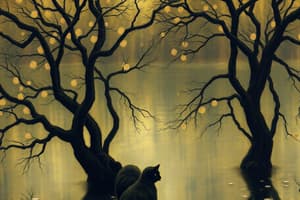Podcast
Questions and Answers
What characterizes an essential discontinuity?
What characterizes an essential discontinuity?
- A point where a function can be redefined to make it continuous.
- A point where the function is not defined.
- A point where the limit does not exist. (correct)
- A point where the function value equals the limit from both sides.
Which of the following is NOT a method to find extrema on a closed interval?
Which of the following is NOT a method to find extrema on a closed interval?
- Evaluating the function at the endpoints of the interval.
- Evaluating the function at critical points within the interval.
- Using the Extreme Value Theorem.
- Finding the concavity using the second derivative test. (correct)
Which statement about vertical asymptotes is TRUE?
Which statement about vertical asymptotes is TRUE?
- Vertical asymptotes always occur where the function crosses the $y$-axis.
- Vertical asymptotes occur where the limit as $x$ approaches infinity is infinite.
- Vertical asymptotes only occur in rational functions.
- Vertical asymptotes occur where the denominator of a rational function is zero. (correct)
What is the purpose of logarithmic differentiation?
What is the purpose of logarithmic differentiation?
Which statement about the Fundamental Theorem of Calculus is FALSE?
Which statement about the Fundamental Theorem of Calculus is FALSE?
In the context of related rates problems, what is the primary method employed?
In the context of related rates problems, what is the primary method employed?
Flashcards are hidden until you start studying
Study Notes
Division by Zero
- Division by zero is undefined in mathematics
- This concept is essential to understand in calculus and other mathematical operations
Limits
- Evaluating limits is a crucial concept in calculus
- One-sided limits are used to evaluate limits from the left or right
- Limit theorems provide rules for evaluating limits
- Vertical asymptotes occur when a function approaches a specific value as the input increases or decreases without bound
- Horizontal asymptotes occur when a function approaches a specific value as the input increases or decreases without bound
Continuity
- Continuity is defined as a function being continuous at a point if the function is defined at that point, the limit exists, and the limit equals the function value
- Types of discontinuities include removable and essential discontinuities
- Theorems on continuity provide rules for determining continuity
- Composite functions can be continuous if the individual functions are continuous
Differentiation
- The derivative is defined as the rate of change of a function with respect to its input
- Differentiability is a necessary condition for a function to be differentiable
- Properties of derivatives include linearity, product rule, and chain rule
- Derivatives of basic functions include power rule, product rule, and quotient rule
- The chain rule is used to differentiate composite functions
- Higher-order derivatives can be used to find the acceleration of a function
- Implicit differentiation is used to find the derivative of an implicitly defined function
- Related rates are used to find the rate at which one quantity changes with respect to another
Extreme Values and Optimization
- Maximum and minimum values can be found using the first derivative test
- Critical numbers are points where the derivative is zero or undefined
- The Extreme Value Theorem states that a continuous function on a closed interval has a maximum and minimum value
- Applications of optimization include modeling real-world problems
- The first and second derivative tests are used to determine the maximum or minimum value of a function
- Concavity and inflection points are used to determine the shape of a function
- Curve sketching is used to visualize the shape of a function
Integration
- The definite integral is defined as the area under a curve between two points
- Properties of definite integrals include linearity and additivity
- The Fundamental Theorem of Calculus relates the derivative of a function to the area under its curve
- The average value of a function can be found using the definite integral
- Sigma notation is used to write the sum of a series
- Areas and volumes can be found using definite integrals
Logarithmic and Exponential Functions
- The natural logarithmic function is defined as the inverse of the exponential function
- The derivative of the natural logarithmic function is 1/x
- Logarithmic differentiation is used to differentiate logarithmic functions
- Logarithmic equations can be solved using logarithmic properties
- Exponential decay is used to model real-world problems
- The integration of exponential functions involves using the natural logarithmic function
- Inverse trigonometric functions can be used to solve trigonometric integrals
Studying That Suits You
Use AI to generate personalized quizzes and flashcards to suit your learning preferences.




